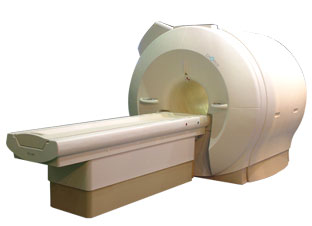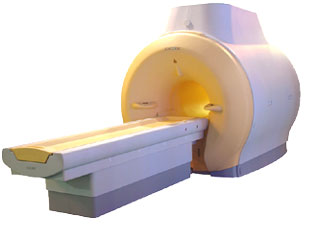 | Info
Sheets |
| | | | | | | | | | | | | | | | | | | | | | | | |
 | Out-
side |
| | | | |
|
| | | | |
Result : Searchterm 'Inversion' found in 17 terms [ ] and 43 definitions [ ] and 43 definitions [ ] ]
| previous 21 - 25 (of 60) nextResult Pages :  [1 2 3 4] [1 2 3 4]  [5 6 7 8 9 10 11 12] [5 6 7 8 9 10 11 12] |  | |  | Searchterm 'Inversion' was also found in the following services: | | | | |
|  |  |
| |
|
Quick Overview
A disturbance of the field homogeneity, because of magnetic material (inside or outside the patient), technical problems or scanning at the edge of the field.
When images were obtained in a progression from the center to the edge of the coil, the homogeneity of the field observed by the imaged volume, changes when the distance from the center of the volume increase.
The same problem appears by scanning at a distance from the isocenter in left-right direction or too large field of view.
There are different types of bad image quality, the images are noisy, distorted or the fat suppression doesn't work because of badly set shim currents.
E.g. by using an IR sequence, changes in the T1 recovery rates of the tissues are involved. The inversion time at the center of the imaged volume is appropriate to suppress fat, but at the edge of the coil the same inversion time is sufficient to suppress water. Since the inversion time is not changed, the T1 recovery rates will increase.

Image Guidance
Take a smaller imaging volume (and for fat suppression a volume shimming), take care that the imaged region is at the center of the coil and that no magnetic material is inside the imaging volume. | |  | | | |  Further Reading: Further Reading: | Basics:
|
|
| |
|  |  | Searchterm 'Inversion' was also found in the following services: | | | | |
|  |  |
| |
|
A pulse sequence is a preselected set of defined RF and gradient pulses, usually repeated many times during a scan, wherein the time interval between pulses and the amplitude and shape of the gradient waveforms will control NMR signal reception and affect the characteristics of the MR images. Pulse sequences are computer programs that control all hardware aspects of the MRI measurement process.
Usual to describe pulse sequences, is to list the repetition time (TR), the echo time (TE), if using inversion recovery, the inversion time (TI) with all times given in milliseconds, and in case of a gradient echo sequence, the flip angle. For example, 3000/30/1000 would indicate an inversion recovery pulse sequence with TR of 3000 msec., TE of 30 msec., and TI of 1000 msec.
Specific pulse sequence weightings are dependent on the field strength, the manufacturer and the pathology.
See also Interpulse Times. | |  | |
• View the DATABASE results for 'Pulse Sequence' (96).
| | |
• View the NEWS results for 'Pulse Sequence' (1).
| | | | |  Further Reading: Further Reading: | | Basics:
|
|
News & More:
| |
| |
|  | |  |  |  |
| |
|
Quick Overview
DESCRIPTION
Signal loss, intensity variations

Image Guidance
| |  | | | |
|  |  | Searchterm 'Inversion' was also found in the following services: | | | | |
|  |  |
| |
|

'Next generation MRI system 1.5T CHORUS developed by ISOL Technology is optimized for both clinical diagnostic imaging and for research development.
CHORUS offers the complete range of feature oriented advanced imaging techniques- for both clinical routine and research. The compact short bore magnet, the patient friendly design and the gradient technology make the innovation to new degree of perfection in magnetic resonance.'
Device Information and Specification
CLINICAL APPLICATION
Whole body
Spin Echo, Gradient Echo, Fast Spin Echo,
Inversion Recovery ( STIR, Fluid Attenuated Inversion Recovery), FLASH, FISP, PSIF, Turbo Flash ( MPRAGE ),TOF MR Angiography, Standard echo planar imaging package (SE-EPI, GE-EPI), Optional:
Advanced P.A. Imaging Package (up to 4 ch.), Advanced echo planar imaging package,
Single Shot and Diffusion Weighted EPI, IR/FLAIR EPI
STRENGTH
20 mT/m (Upto 27 mT/m)
| |  | |
• View the DATABASE results for 'CHORUS 1.5T™' (2).
| | | | |
|  |  | Searchterm 'Inversion' was also found in the following services: | | | | |
|  |  |
| |
|

'MRI system is not an expensive equipment anymore.
ENCORE developed by ISOL Technology is a low cost MRI system with the advantages like of the 1.0T MRI scanner. Developed specially for the overseas market, the ENCORE is gaining popularity in the domestic market by medium sized hospitals.
Due to the optimum RF and Gradient application technology. ENCORE enables to obtain high resolution imaging and 2D/3D Angio images which was only possible in high field MR systems.'
- Less consumption of the helium gas due to the ultra-lightweight magnet specially designed and manufactured for ISOL.
- Cost efficiency MR system due to air cooling type (equivalent to permanent magnetic).
- Patient processing speed of less than 20 minutes.'
Device Information and Specification
CLINICAL APPLICATION
Whole body
CONFIGURATION
Short bore compact
| |  | |
• View the DATABASE results for 'ENCORE 0.5T™' (2).
| | | | |
|  | |  |  |
|  | |
|  | | |
|
| |
 | Look
Ups |
| |